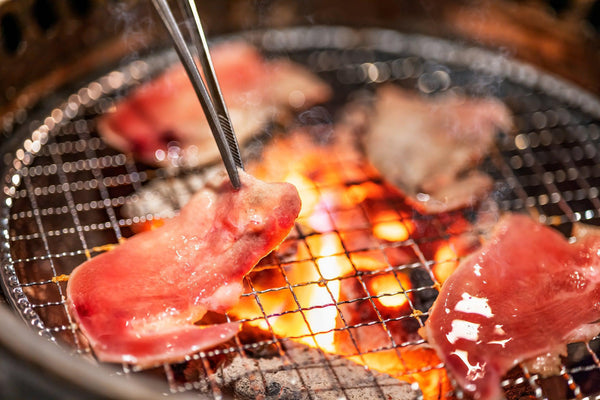
Jump to:
Are you familiar with yakiniku? It's Japan’s take on barbeque, and everyone loves it. In fact, there are yakiniku restaurants found in just about every town and city across the country. It’s heavily influenced by Korean BBQ, which you might already be familiar with, but of course with its own twist. What even makes it so popular to begin with, and is it easy to enjoy yakiniku outside of Japan?
In this article, we’ll cover everything you need to know about yakiniku, and we’ll also share tips, tricks, and recommendations for having the best and most authentic yakiniku experience at home.
What Is Yakiniku?

First, let’s cover the basics of what yakiniku actually is. The word "yakiniku" is a Japanese word meaning "grilled meat." Yakiniku is influenced by Korean BBQ, where it originated from, and was first imported to Japan by Korean immigrants. Since then, it has evolved to suit Japanese tastebuds, but you can still find Korean side dishes often served in yakiniku restaurants.
Eating yakiniku is an enjoyable and social experience where families and friends sit around the grill together and cook the meat themselves. While many restaurants specialize in yakiniku, it can also be enjoyed at home too. Below is a checklist of items you’ll need followed by further details and tips for making yakiniku at home:
Eating yakiniku is an enjoyable and social experience where families and friends sit around the grill together and cook the meat themselves. Read on to find out more details about the items you’ll need to create an authentic Japanese BBQ experience at home. Below is a checklist of items you’ll need followed by further details and tips:
- An indoor, portable grill – choose from electric, amiyaki (grill on net) or teppanyaki (grill on iron plate.) We really love this one from Ikenaga Iron Works. If you do not have a portable grill, you can also use an iron plate over the stove like this one.
- Cooking tools and utensils – invest in high-quality BBQ tongs that can be used over and over and some Japanese tableware. If you’re looking for recommendations, Todai is a great brand to check out because they specialize in making many grilling and yakiniku-specific products.
- A variety of meat and vegetables – thinly sliced cuts of beef tend to be the most popular choice of meat for yakiniku, but pork and chicken are also commonly grilled too. Of course you’ll need some veggies too! We recommend thinly sliced onions, eggplant, kabocha squash, mushrooms, and green peppers.
- Sauces and marinades – recommended dipping sauces include tare-based sauces, salt-based sauces, and miso-based sauces.
- Side dishes – yakiniku is commonly served with Korean side dishes like kimchi or other pickles. You can also pair your yakiniku with salad or steamed rice. Preparing lettuce leaves on the side for making yakiniku lettuce wraps has also become more common recently due to the rise in popularity of samgyupsal.
- Top tips for cooking yakiniku like a pro – cook lean and unseasoned meat before fatty or marinated meats.
- Alcohol and drinks – enjoy Japanese beer or other alcoholic drinks like highball, chuhai, and umeshu. Tsuki no Katsura’s Japanese sake also makes a great drink of choice for enjoying with yakiniku. Of course, soft drinks are perfectly acceptable too.
- Looking for more yakiniku recommendations? Be sure to check out our Japanese BBQ collection in case you’re missing anything!
Equipment For Making Yakiniku
To make yakiniku at home you’ll need a portable grill that can ideally be used indoors, such as an indoor electric grill. In Japan, yakiniku is usually cooked on one of two kinds of grills over charcoal – amiyaki or teppanyaki. Amiyaki is a wired net grill, whilst teppanyaki is an iron plate grill.
If you’re using charcoal to cook your yakiniku, then we recommend cooking your yakiniku outside and purchasing binchotan charcoal if possible, which is a type of charcoal traditionally used in Japanese cooking. It burns longer than ordinary charcoal, has minimal smoke, and does not taint the taste of the food it’s cooking.
Yakiniku Cooking Utensils & Tableware

When cooking yakiniku, you’ll need a good set of tongs for grilling the meat that makes it easy to turn the food without getting your hand too close to the heat. We recommend investing in a high-quality set like these Todai Stainless Steel Yakiniku BBQ Clever Tongs which are designed for cooking yakiniku, are extra durable, and can be left on the table without the tip touching it, making them more hygienic too.
If you buy Japanese beef, it will come pre-prepared in thin strips or slices that are easy to grill so you won’t need to cut up the meat into smaller pieces prior to cooking. However, if you are not able to buy Japanese beef then you will also need a good pair of kitchen scissors or a carving knife to cut the meat into individual-sized portions prior to cooking.
For serving you’ll also need some small side plates for each person to place the cooked meat onto and for any other side dishes, individual sauce dishes for each person to dip the meat into, rice bowls if you are serving rice alongside the meat, chopsticks, and chopstick rests.
Most Popular Meats For Yakiniku

Although any kind of meat can be cooked at yakiniku such as chicken or pork, beef is by far the most popular choice. As wagyu (Japanese beef) is usually quite expensive to buy in supermarkets, yakiniku is a good opportunity to eat a lot of meat at a reasonable price with many yakiniku restaurants offering ‘all you can eat’ menus. Here are five of the most popular beef cuts used in yakiniku BBQ:
Short Ribs – known as karubi in Japanese, boneless short ribs are one of the most popular yakiniku cuts. These marbled cuts are full of flavor and are very tender. These slices of marbled beef cook very quickly and taste best cooked to medium rare or medium.
Beef Tongue – known as tan in Japanese, beef tongue is a popular delicacy and is served at yakiniku restaurants in very thin slices that tastes best cooked rare and served with a salt-based sauce. Tongue should be cooked first at yakiniku so that its unique flavor is not affected by the fats from the other meat cuts.
Roast and Rib Roast – these are lean cuts from the shoulder, whilst rib roast refers to the meat at the back of the ribs, closer to the sirloin cuts and which has a little more marbling. It is one of the top cuts of beef alongside sirloin. These cuts are usually served in thicker slices, so they take a bit longer to cook.
Skirt Steak – known as harami in Japanese, this cut of beef comes from the diaphragm area, has a strong umami flavor, and is often marinated in miso or soy sauce. As harami is leaner than other cuts, it will need cooking a little longer to bring out its full flavor.
Sirloin – one of the most expensive cuts, good quality sirloin is tender, juicy, and full of flavor, which is why it’s also one of the most popular cuts for steaks. Marbled wagyu sirloin is particularly delicious when cooked in yakiniku as the fat gives the beef extra umami flavor.
Other Meats & Veggies In Yakiniku
In addition to beef, other popular meats you can find at yakiniku include pork belly, chicken breast and chicken thighs, shrimp, and sausages. Yakiniku tends to make the most out of all cuts of meat, so it is not uncommon to see unusual cuts of meat such as horumon (offal) heart, liver, and more. It may sound a bit strange to eat such cuts of meat, but you might actually be surprised about how tasty these cuts can taste when cooked and paired with a yakiniku dipping sauce.
Of course, getting your veggies in is equally important as eating meat in yakiniku. There is no shortage of yummy veggies in yakiniku either. There is usually a large selection of vegetables to choose from such as cabbage, onion, mushrooms, corn on the cob, and carrots. However, if you’re hosting your own yakiniku party at home, feel free to go wild with your favorite veggies.
Sauces & Marinades For Yakiniku

Yakiniku meat is usually served with a selection of dipping sauces: a tare sauce, a salt-based sauce, and a miso-based sauce. Tare sauce has a sweetened thickened soy sauce flavor and includes ingredients such as soy sauce, sake, mirin, and sugar. If you want to make your own yakiniku sauce, you can find a great recipe online here or alternatively you can buy a readymade sauce from the Japanese Taste website here.
Other seasonings and accompaniments that you can serve with yakiniku include rock salt which helps to bring out the beef’s umami flavor, soy sauce with wasabi, yuzu pepper, karashi mustard, gochujang, and lemon – which pairs especially well with beef tongue.
How To Cook Yakiniku
Although you can just throw the meat on the grill in any order you like – here are a few pro cooking tips that will help to bring out the best flavors in the meat:
- Eat the meat immediately after serving.
- Try to cook the cuts with lighter flavors first or cuts that have not been seasoned with sauce and save the stronger flavors for later so the meat is not contaminated by the taste of other cuts.
- Try to cook leaner cuts before fatty cuts so the leaner cuts aren’t contaminated by burnt fat on the grill.
- Grill lean meat for a shorter amount of time to avoid toughness
- Cook fattier meats for a little longer than other cuts to bring out the tenderness when the fat melts.
Side Dishes To Go With Yakiniku
In addition to the meat and vegetables that you are grilling, here are some popular side dishes that go well with yakiniku: steamed rice, salad, miso soup, Japanese-style potato salad, edamame, kimchi, and namul.
As cooking yakiniku is often quite a hot experience thanks to the heat from the grill, a dish such as ice cream or chilled fruits to finish make for a welcome dessert.
Alcohol & Drinks To Serve With Yakiniku

A frosted glass of beer is a popular drink to consume with yakiniku along with other Japanese alcoholic beverages like chuhai – a fruit flavored drink mixed with shochu and soda, umeshu (plum wine), and highballs (whisky and soda). For non-alcoholic options you could serve soft drinks like soda or fruit juice, or even some Japanese soft drinks like Calpis – a milky sweet drink, and ramune – a popular citrus-flavored soda drink.
Where To Buy Yakiniku Ingredients & Utensils Online
You can buy many of the items you need for yakiniku like sauces, seasonings, tongs, and ingredients for side dishes from the Japanese Taste website who will ship authentic Japanese products directly from Japan to your door.
Have you tried yakiniku before? What is your favorite way to enjoy it? Let us know about your yakiniku experience in the comments below.


2 comments
Hi Sita, thanks for checking out our article! We hope you’ll use some of our tips at home if you decide to host your own epic yakiniku party! ;)
Japanese Taste,
Marvelous ideas, thanks! I had not thought of serving kimchi or Kubota squash. Also the sauces. Yum!
Sita,